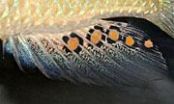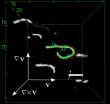Mining big data yields Alzheimer's discovery
2014-10-09
(Press-News.org) Scientists at The University of Manchester have used a new way of working to identify a new gene linked to neurodegenerative diseases such as Alzheimer's. The discovery fills in another piece of the jigsaw when it comes to identifying people most at risk of developing the condition.
Researcher David Ashbrook and colleagues from the UK and USA used two of the world's largest collections of scientific data to compare the genes in mice and humans. Using brain scans from the ENIGMA Consortium and genetic information from The Mouse Brain Library, he was able to identify a novel gene, MGST3 that regulates the size of the hippocampus in both mouse and human, which is linked to a group of neurodegenerative diseases. The study has just been published in the journal BMC Genomics.
David, who works in Dr Reinmar Hager's lab at the Faculty of Life Sciences, says: "There is already the 'reserve hypothesis' that a person with a bigger hippocampus will have more of it to lose before the symptoms of Alzheimer's are spotted. By using ENIGMA to look at hippocampus size in humans and the corresponding genes and then matching those with genes in mice from the BXD system held in the Mouse Brain Library database we could identify this specific gene that influences neurological diseases."
He continues: "Ultimately this could provide another biomarker in the toolkit for identifying those at greatest risk of developing diseases such as Alzheimer's."
Dr Hager, senior author of the study, says: "What is critical about this research is that we have not only been able to identify this specific gene but also the networks it uses to influence a disease like Alzheimer's. We believe this information will be incredibly useful for future studies looking at treatments and preventative measures."
The ENIGMA Consortium is led by Paul Thompson based at the University of California, Los Angeles, and contains brain images and gene information from nearly 25,000 subjects. The Mouse Brain Library, established by Robert Williams based at the University of Tennessee Health Science Center, contains data on over 10,000 brains and numerical data from just over 20,000 mice.
David explains why combining the information held by both databases is so useful: "The key advantage of working this way is that it is much easier to identify a genetic variant in mice as they live in such controlled environments. By taking the information from mice and comparing it to human gene information we can identify the same variant much more quickly."
And David thinks this way of working will be used more often in the future: "We are living in a big data world thanks to the likes of the Human Genome Project and post-genome technologies. A lot of that information is now widely shared so by mining what we already know we can learn so much more, advancing our knowledge of diseases and ultimately improving detection and treatment."
INFORMATION:
ELSE PRESS RELEASES FROM THIS DATE:
2014-10-09
A new measurement of dark matter in the Milky Way has revealed there is half as much of the mysterious substance as previously thought.
Australian astronomers used a method developed almost 100 years ago to discover that the weight of dark matter in our own galaxy is 800 000 000 000 (or 8 x 1011) times the mass of the Sun.
They probed the edge of the Milky Way, looking closely, for the first time, at the fringes of the galaxy about 5 million billion kilometres from Earth.
Astrophysicist Dr Prajwal Kafle, from The University of Western Australia node of the International ...
2014-10-09
PITTSBURGH, Oct. 9, 2014 – National guidelines for the cleaning of certain gastrointestinal (GI) scopes are likely to be updated due to findings from UPMC's infection prevention team.
The research and updated disinfection technique will be shared Saturday in Philadelphia at ID Week 2014, an annual meeting of health professionals in infectious disease fields.
"Patient safety is our top priority," said senior author Carlene Muto, M.D., M.S., director of infection prevention at UPMC Presbyterian Hospital. "We are confident that the change from disinfection to sterilization ...
2014-10-09
PITTSBURGH, Oct. 9, 2014 – UPMC Presbyterian Hospital's infection prevention teams have improved hand washing and sanitizing compliance at the hospital to nearly 100 percent among clinical staff through accountability and educational measures. In a separate effort at UPMC Mercy Hospital, rates of a deadly infection were reduced by educating patients about hand hygiene.
The successful techniques will be reported Saturday in presentations in Philadelphia at ID Week 2014, an annual meeting of health professionals in infectious disease fields.
"Hand hygiene compliance ...
2014-10-09
No matter what type of chemotherapy you attack a tumor with, many cancer cells resort to the same survival tactic: They start eating themselves.
Scientists at Brigham Young University discovered the two proteins that pair up and switch on this process – known as autophagy.
"This gives us a therapeutic avenue to target autophagy in tumors," said Josh Andersen, a BYU chemistry professor. "The idea would be to make tumors more chemo-sensitive. You could target these proteins and the mechanism of this switch to block autophagy, which would allow for lower doses of ...
2014-10-09
The evolution of new traits with novel functions has always posed a challenge to evolutionary biology. Studying the color markings of cichlid fish, Swiss scientists were now able to show what triggered these evolutionary innovations, namely: a mobile genetic element in the regulatory region of a color gene. Their results have been published in the latest issue of the renowned scientific journal Nature Communications.
Biological evolution is in general based on the progressive adaption of traits through natural or sexual selection. However, ever so often, complex traits ...
2014-10-09
Ebola, as with many emerging infections, is likely to have arisen due to man's interaction with wild animals – most likely the practice of hunting and eating wild meat known as 'bushmeat'. A team of researchers led by the University of Cambridge and the Zoological Society of London (ZSL) has surveyed almost six hundred people across southern Ghana to find out what drives consumption of bat bushmeat – and how people perceive the risks associated with the practice.
The Straw-Coloured Fruit Bat, Eidolon helvum, is widely hunted and eaten in Ghana, but carries ...
2014-10-09
Carbon capture is a process by which waste carbon dioxide (CO2) released by factories and power plants is collected and stored away, in order to reduce global carbon emissions. There are two major ways of carbon capture today, one using powder-like solid materials which "stick" to CO2, and one using liquids that absorb it. Despite their potential environmental and energy benefits, current carbon capture strategies are prohibitive because of engineering demands, cost and overall energy-efficiency. Collaborating scientists from EPFL, UC Berkley and Beijing have combined carbon-capturing ...
2014-10-09
Jülich, Germany, 9 October 2014 – When a basically sturdy material becomes soft and spongy, one usually suspects that it has been damaged in some way. But this is not always the case, especially when it comes to complex fluids and biological cells. By looking at the microscopic building blocks – known as "filaments" – of biopolymer networks, researchers from Forschungszentrum Jülich, Germany and the FOM Institute AMOLF in the Netherlands, revealed that such materials soften by undergoing a transition from an entangled spaghetti of filaments to ...
2014-10-09
Some 340 European scientists, policy-makers and other experts representing 143 organizations from 31 countries spoke with one voice today, publishing a common vision of today's most pressing marine-related health and economic threats and opportunities.
In a declaration concluding a three day meeting in Rome, EurOcean 2014 participants also released an agreed, five-year roadmap to achieve expanded, more integrated and effective policy-oriented ocean scrutiny.
EurOcean 2014 was convened by the Italian Presidency of the Council of the European Union, the European Marine ...
2014-10-09
Nyon, Switzerland (October 9, 2014) – Alarming new data published today by the International Osteoporosis Foundation (IOF), shows that one-third of all hip fractures worldwide occur in men, with mortality rates as high as 37% in the first year following fracture. This makes men twice as likely as women to die after a hip fracture. Osteoporosis experts warn that as men often remain undiagnosed and untreated, millions are left vulnerable to early death and disability, irrespective of fracture type.
The report entitled 'Osteoporosis in men: why change needs to happen' ...
LAST 30 PRESS RELEASES:
[Press-News.org] Mining big data yields Alzheimer's discovery



